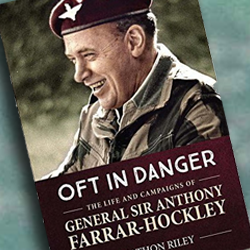
Oft In Danger:
The life and Campaigns of General Sir Anthony Farrar-Hockley
Book Review By David Benest
 This is a remarkable account of one of Britain’s finest soldiers, with a Foreword by Field Marshal Lord Brammall. The author himself has had a most distinguished military record and makes very clear at the outset that this is no hagiography, given that ‘Farrar-the-PARA’, or ‘TFH’ for all his many achievements, was not the epitome of perfection, as his many confidential reports make clear – but then again, who does fit such a place in the annals of military service?
This is a remarkable account of one of Britain’s finest soldiers, with a Foreword by Field Marshal Lord Brammall. The author himself has had a most distinguished military record and makes very clear at the outset that this is no hagiography, given that ‘Farrar-the-PARA’, or ‘TFH’ for all his many achievements, was not the epitome of perfection, as his many confidential reports make clear – but then again, who does fit such a place in the annals of military service?
TFH’s youth was much like another, where school life was distinctly low on his list of priorities – enlistment in the Army was. His own thoughts, aged 16 years, on what war was to mean for him and especially his poem, ‘Written on Hearing of the Outbreak of War, September 1939’ deserves widespread dissemination.
His time in WW2 as a young office was itself the experience of a lifetime: the battles in North Africa; Italy; and then the parachute assault into southern France with 2 Para Brigade; not to mention participation in the civil war in Greece on the side of the allies. But TFH ‘continued the movement’ and joined his county Regiment, the Glosters, as adjutant and in time for the Imjin River battle, after which he was captured by the North Koreans. He attempted no fewer than six escapes and eventually was tortured by ‘water boarding’. Following Korea, TFH returned to airborne forces and took part in the EOKA operations on Cyprus as well as the parachute assault into Egypt in November 1956. The next decade saw him heavily committed to ‘Confrontation’ in Borneo and then as Commanding Officer 3 PARA, in the Radfan. In the early 1970s as a major general, he was appointed as Commander Land Forces (CLF) in Northern Ireland, subsequently targetted with an IED at his home by the Provisional IRA (PIRA). Unusually for someone with an airborne background, he was nevertheless appointed as GOC 4TH Armoured Division on NATO’s Central Front and then finally as C-in-C Allied Forces Northern Europe from 1979 to 1981, based in Oslo but also including forces in North Germany, Denmark and reinforcements from the UK. By now he was also a prolific scholar, having written the official history of the Korean war, and his own account of that war, ‘The Edge of the Sword’, together with his Defence fellowship dissertation on national service.
TFH was a devout Christian and hence the title of this biography, extracted from English Hymnal No 467. He espoused views that today might be seen as ‘outdated’ on matters such as homosexuality, female soldiers and ‘political correctness’. He was first and foremost a great leader: decisive; with integrity; could communicate, both in the sense of listening and giving clear direction; was professionally knowledgeable and with great humility; was willing to experiment with new concepts; a man of vision; and above all, was capable of developing a team around him, with loyalty upwards, sideways and downwards, usually with great humour. His final years were not easy, suffering Parkinson’s disease, hallucinations and dementia. He died on Saturday 11 March 2006, aged 82 years – a remarkable life. If ever the motto of Sandhurst were to be applied to any individual, it would be to TFH, who ‘Served to Lead’. In this volume, Jonathan Riley has made a remarkable contribution to military history, as he did recently with the biography of Hugh Stockwell. His research is impeccable, almost, and the account benefits from over 160 illustrations, together with 35 maps. His written style is engaging and succinct, capturing where he can the more bizarre aspects of the life of TFH – in all, a masterpiece of military biography – well done JR!
David Benest